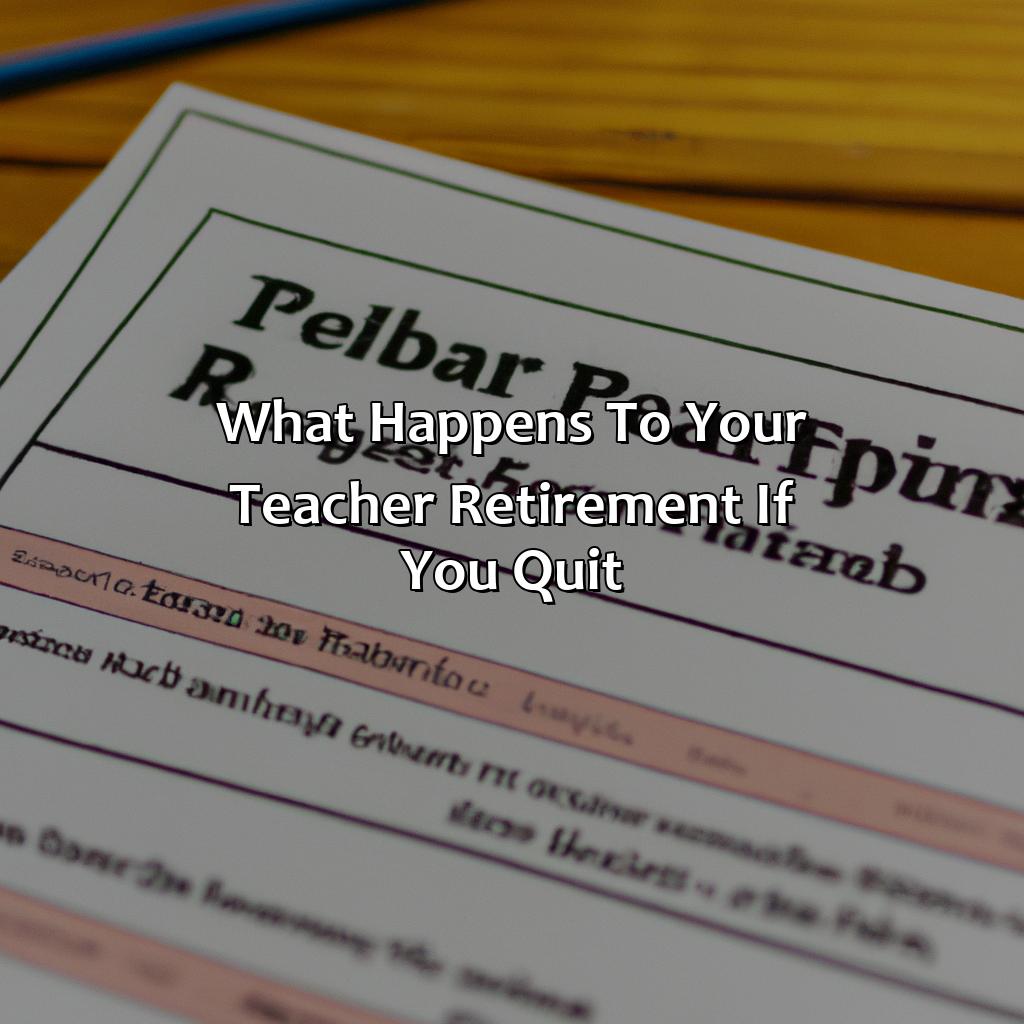What Happens To Your Teacher Retirement If You Quit?
Key Takeaway:
- Vesting requirements determine when you are eligible to receive your retirement funds. If you leave teaching before you are fully vested, you may not be entitled to the full amount of your retirement funds.
- Withdrawal options vary depending on the type of retirement plan you have. Some plans may allow you to withdraw your funds immediately, while others may require you to wait until you reach a certain age or meet other criteria.
- Rolling over your retirement plan is a good option if you want to continue saving for retirement. It allows you to transfer your retirement funds to another tax-deferred account without incurring taxes or penalties.
Are you considering leaving teaching and want to know what happens to your retirement benefits? Whether you are investing in a teacher retirement plan or a 401K, you need to know how quitting will impact your retirement savings. Read this article to help protect your future financial security.
What Happens to Your Retirement Plan When You Quit Teaching?
For a successful transition from teaching, be informed on retirement plan details. Let us explore these essential topics:
- Vesting Requirements
- Withdrawal Options
- Considerations for Rolling Over
All of these are related to ‘What Happens to Your Retirement Plan When You Quit Teaching.’

Image credits: retiregenz.com by Yuval Arnold
Vesting Requirements for Retirement Plans
Retirement Plan Requirements: What You Need to Know
Retirement plan vesting requirements may vary depending on your career path and employer. It is crucial to know the policies of your retirement plan. Vesting means being entitled to the full benefits of your plan once you meet certain qualifications like the years worked.
If you are a teacher, your pension plan may have different factors in their calculation, and there could be restrictions on when employees can fully cash out. Teachers often obtain vestment after five years of service and can retire with full benefits after completing a minimum of 30 years.
It is worth noting that if you leave teaching before becoming vested, you may lose all earned retirement contributions, including government matching funds. Ensure you are aware of all applicable vesting periods when making choices that affect your contributions or departure from teaching.
Neglecting vesting requirements can lead to loss of earned retirement money which may impact financial standing during old age. Therefore, it’s essential to stay informed about retirement plans and avoid leaving any matched contributions unclaimed while making employment decisions.
Don’t withdraw your retirement funds like it’s a game of Jenga, unless you want your financial future to come crashing down.
Withdrawal Options for Retirement Funds
There are multiple ways to access your retirement funds if you decide to leave the teaching profession. Here are some literal meanings of Withdrawal Options for Retirement Funds for you:
- Accessing Retirement Funds After Quitting Teaching:
- Withdrawal without Penalty
- Rollover Your Plan
- Transferring Your Fund to a Different Account
- Withdrawing Retirement Funds When You Quit Teaching:
- Penalty-Free Withdrawal Option
- Rollover Your Plan Into an IRA Account
- Cashing Out Your Account Balance Directly
It’s important to note that some of these alternatives may lead to taxes and penalties, depending on your current teacher retirement plan.
If you choose rollover options when quitting teaching, make sure that you transfer the funds correctly and carefully. Failing to do so may result in unwanted tax liabilities or additional fees.
To ensure that you don’t miss out on any benefits from your retirement plan, consult with a financial advisor before making any significant changes.
Don’t let the fear of missing out on your retirement benefits rule over you. Ensure that you have all relevant information at hand as early as possible so that each decision made is informed and precise.
Rolling over your retirement plan is like switching to a new teacher mid-class, just with more money and less awkward introductions.
Considerations for Rolling Over Retirement Plans
Retirement plans are vital for everyone, including teachers. When leaving their jobs, educators must consider rolling over their retirement plans into another account to ensure the safety of their funds. Withdrawing funds from the current plan without proper planning may result in unnecessary penalties and taxes.
Teachers have the option of transferring their retirement plans to an Individual Retirement Account (IRA) or a new employer’s plan. Rolling over to an IRA allows for more flexibility and diverse investment options than traditional employer plans; however, it is crucial to ensure that any fees associated with the transfer do not cancel out any benefits gained.
Furthermore, Teachers must take note of vesting requirements before leaving employment and calculate how much they will gain through employer contributions. Leaving too early may reduce or forfeit these contributions if not vested fully.
If you quit teaching, your pension and social security benefits may also quit on you like a bad Tinder date.
Impact of Quitting on Pension and Social Security Benefits
Comprehending the consequence of quitting teaching on pension and social security is key. Be familiar with teacher pension plans. This will guide you through the complexities of what happens to your retirement benefits when you quit. Quitting may influence your social security benefits. So, understand the potential alterations.

Image credits: retiregenz.com by Harry Washington
Understanding Pension Plans for Teachers
Pension Plans for Educators: A Guide
A comprehensive understanding of pension plans awaits you. For educators in particular, the stakes are high when it comes to making informed decisions about retirement. In this guide, we will delve deeper into pension benefits and how they work for teachers.
For teachers contemplating leaving their jobs early, it’s important to know how quitting might impact their future earnings. Under some pension plans, exiting before reaching full eligibility will significantly lower your benefits. To prevent any unwelcome surprises down the road, it’s essential to understand how these plans operate.
One of the unique characteristics of teacher pension systems is that they tend to be generous compared with other professions’ retirement benefits. This is why most educators remain dedicated to their jobs until full retirement eligibility.
Historically, teacher pensions have been a reliable source of financial security for many retirees. With that said, rumblings about the stability of the system have caused concern among younger educators who worry if they’ll ever see a dime from their months and years of service.
Quitting your job may give you a new sense of freedom, but your social security benefits may feel like they’ve quit on you.
Impact on Social Security Benefits After Quitting
The decision to quit a job may have an impact on your Social Security Benefits. Your pension benefits may affect the eligibility and amount of your Social Security Benefits. It is important to evaluate the implications before quitting.
When you earn a pension from non-Social Security covered work, such as teaching, it can lead to reduced Social Security Benefits through the Windfall Elimination Provision (WEP). The WEP reduces an individual’s Social Security Benefit based on their pension from non-covered work.
Additionally, if an individual leaves their job before they become eligible for a pension, they may not be entitled to receive any retirement benefits from that employer.
It is crucial to understand how quitting affects your long-term financial security. Consider consulting with a financial advisor before making any decisions about quitting your job.
A former teacher decided to retire early and experienced significant reductions in her Social Security Benefits due to her pension. She advises doing extensive research and understanding the trade-offs before making any decisions about quitting.
Five Facts About What Happens to Your Teacher Retirement if You Quit:
- ✅ Depending on state laws, you may lose certain retirement benefits if you leave teaching before a certain number of years of service. (Source: Kiplinger)
- ✅ You may be able to roll over your retirement savings into an Individual Retirement Account (IRA) if you leave teaching before retirement age. (Source: Investopedia)
- ✅ If you have a pension, leaving teaching before retirement age may result in a reduced benefit. (Source: The Motley Fool)
- ✅ You may be eligible for a refund of your contributions to a retirement plan if you leave teaching before becoming vested. (Source: SmartAsset)
- ✅ Consider speaking with a financial advisor to understand the potential impact of leaving teaching on your retirement savings. (Source: US News & World Report)
FAQs about What Happens To Your Teacher Retirement If You Quit?
What happens to your teacher retirement if you quit?
If you quit your teaching job before you are eligible for retirement, you may be wondering what will happen to your Teacher Retirement System (TRS) pension.
Will you be able to receive your pension benefits?
Unfortunately, if you quit your teaching job before you are eligible for retirement, you will not be able to receive your pension benefits.
What happens to your contributions to the retirement system?
Your contributions to the TRS retirement system are still yours. When you quit, you can withdraw your contributions or leave them in the system. If you leave your contributions in the system, they will continue to earn interest.
Can you transfer your retirement benefits to another system?
If you are leaving one position to take another public school position, you may be able to transfer your retirement benefits from one system to another. However, private sector jobs do not usually have retirement systems that are compatible with TRS.
Do you have to pay taxes on your retirement contributions?
You have already paid taxes on your contributions to the TRS retirement system when you earned the money. Therefore, you do not have to pay taxes again when you withdraw your contributions.
How do you withdraw your contributions from the TRS retirement system?
You can withdraw your contributions from the TRS retirement system by completing a withdrawal application and submitting it to TRS. However, if you withdraw your contributions, you will forfeit any future benefits from the retirement system.







